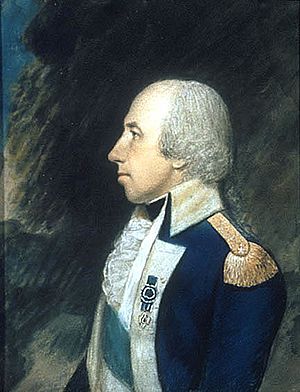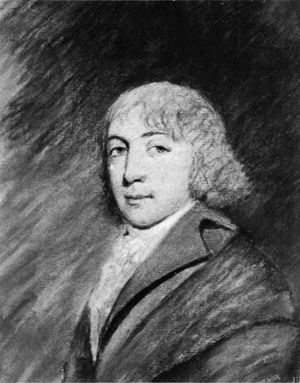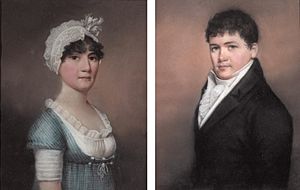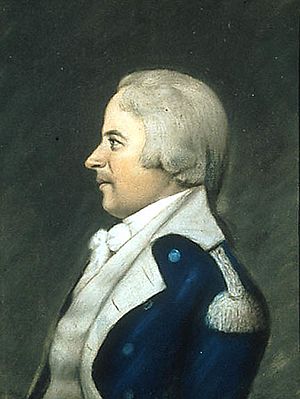James Sharples (portrait painter) facts for kids
Quick facts for kids
James Sharples
|
|
|---|---|
| Born |
James Sharples
1751 or 1752 |
| Died | 1811 New York City, U.S.
|
| Nationality | English |
| Known for | Painting, Pastelist |
| Movement | Portrait, Silhouette |
James Sharples (born in 1751 or 1752 in Lancashire, England – died February 26, 1811, in New York City) was an English artist. He was known for painting portraits, especially using pastels. He moved to the United States in 1794 and first showed his art at the Royal Academy in 1779.
Biography of James Sharples
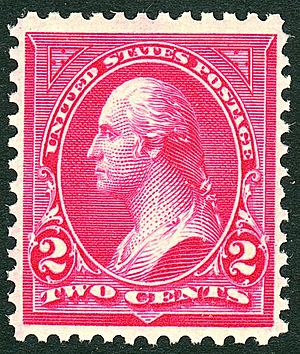
James Sharples first thought about becoming a priest in the Catholic Church. But he decided to become an artist instead. His family became a group of successful portrait artists. This included his third wife, Ellen Sharples.
James had four children. George was from his first marriage. Felix Thomas Sharples (born around 1786) was from his second marriage. James Sharples Jr. (born around 1788) and Rolinda Sharples (born 1793) were with Ellen. Felix, James Jr., and Rolinda joined the family art business when they were young teens.
Before marrying Ellen Wallace, James worked in different English cities. These included Bristol, Liverpool, and Bath. He taught drawing there. The family moved to the United States in 1796. However, their ship was captured by the French. The family spent seven months in Brest, France.
After landing in New York, James quickly became popular. He was known for his small pastel portraits and miniatures. From 1796 to 1801, he mainly worked in Philadelphia and New York. He received many requests to paint portraits. The family traveled around the New England area. They were "itinerant" artists, meaning they traveled to find work. They made inexpensive copies of portraits of famous people. These included George Washington and James Madison.
The Sharples family became known for their accurate portraits. They also earned a good amount of money. Their small pastel portraits were a great choice. They were an alternative to larger, formal oil paintings. Artists like Gilbert Stuart made these bigger paintings. The Sharples' work helped the growing portrait industry in the early United States.
In 1801, the Sharples family returned to England. They had problems with their house lease in Bath. The war between France and Britain (the Napoleonic Wars) delayed their return to the United States. Felix and James Jr. went back to America in 1806. Their parents and sister Rolinda followed in 1809. James Sharples died in 1811 during a very cold winter. After his death, the family returned to England. Only Felix chose to stay in America.
James Sharples' Paintings
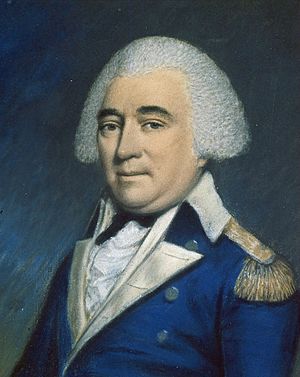
James Sharples started his career in America in 1794. He offered to draw profiles of local and national politicians. He then used these original portraits as examples for new clients. He also made copies of the originals to sell.
At this time, copies of portraits of famous people were very popular. But there was a lot of competition among artists. Many artists had to travel to find customers. Sharples often used a tool called a physiognotrace. This was a mechanical drawing aid. It helped him draw an exact profile. He kept these original profiles for his own collection. Then, he would make copies to sell.
He also painted pastel portraits that showed the upper body. His style was delicate and precise. He mainly used black, white, and grey colors. The skin in his paintings looked natural. The backgrounds were usually blue.
Making copies of his portrait of George Washington was a main part of Sharples' business. This was similar to how Gilbert Stuart made many oil copies of his Washington portrait. The Sharples family charged $15 for a profile drawing. They charged $25 for a full-face portrait.
Sharples painted many important people. These included George Washington, Thomas Jefferson, Hester Thrale, Joseph Priestley, James Madison, Dolley Madison, John Adams, and Elihu Hubbard Smith. All members of the Sharples family helped make copies of the original portraits. Because of this, it can sometimes be hard to tell the original from a copy.
One portrait, once thought to be General James Wilkinson, was re-identified. An expert named David Meschutt realized the figure was a soldier. He compared the portrait to a list of Sharples' works. Meschutt then identified the figure as General William Hull. This was confirmed by comparing it to another portrait of General Hull.
James Sharples showed his art before he moved to America. Here is a list of some of his paintings that were shown:
- 1779 – Two paintings: A lady; Two gentlemen
- 1782 – Portrait of a lady of quality; nobleman; crayons (Duke of Northumberland, Walpole)
- 1783 – Portrait of a lady; a gentleman; a lady; fruit girl in the wind
- 1785 – A Newcastle lady in the character of Spring; portrait of a young lady; gentleman; lady
Links to Paintings
- George Washington Portrait, Virginia Historical Society
- Albert Gallatin, Metropolitan Museum
- Mrs. Horace Johnson, The AMICA Library
- Portrait of Nelly Custis, Mount Vernon
- Art Encyclopedia


